The Mining Company Life Cycle Explained
Published 11-MAR-2022 11:37 A.M.
|
7 minute read
Basically, a junior resource company’s journey from being worth “not very much”, to hopefully being “worth a LOT” can be summarised in the following steps:
- Explore in search of a resource deposit
- (Hopefully) find a resource deposit, then figure out how big and valuable it is
- Work out whether it is worth investing money to extract the resource from the ground
- If yes, design and construct all the stuff required to extract the resource and ship it to market
- Find somebody to buy it – “sign an offtake agreement”
- Start extracting and shipping. This is called “production”, in other words... making money
The purpose of this article is to do a deep dive into the life cycle of a "Resource company" from exploration through to production and everything in between.
At the end of this article, we hope you will be well aware of what a resource company is trying to do and all of the risks to look out for when investing in junior mining companies.
Discover the 5 Battery Materials Stocks we’ve Invested in for 2023
Resource Company Life Cycle
The following diagram illustrates a mining company's life cycle, from exploration through to production, with more formal names for each phase:
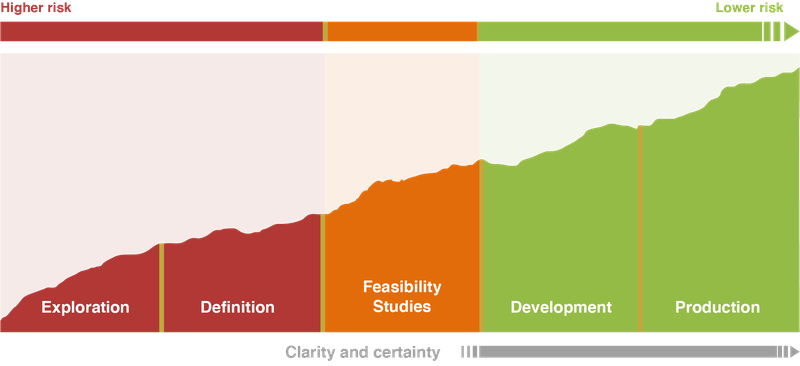
Below we will explain each of these phases.
Exploration: Explore for a resource deposit
This is the first phase in the life of a resource company. We really should be calling it a “resource exploration company” at this stage.
Generally, the company needs to raise a bit of money (YOUR money if you invest) to fund the exploration of a mining lease or exploration permit in search of a mineral deposit.
The exploration phase is where the biggest share price gains are likely to be made, but also the biggest losses.
Successful exploration and discoveries can result in dramatic increases in a company’s share price. On the flipside this is the riskiest stage of a company’s life.
Definition: Found a resource deposit? Time to figure out how big and valuable it is.
Let’s say that the exploration phase has been successful and a discovery has been made (if you were invested at this point you would have made some good gains).
The company will now need to figure out exactly how big (and valuable) this discovery is.
This is known as the definition phase.
Discovered deposits can be classified as resources or reserves. The difference being how confident the company is that the deposit is valuable and extractable. In summary, reserves are better than resources... and here is why:
Resources are potentially valuable, with reasonable prospects for eventual economic extraction. Resources can be classified as inferred, indicated or measured.
Reserves are valuable, and legally, economically and technically feasible to extract. Reserves can be classified as proven or probable.
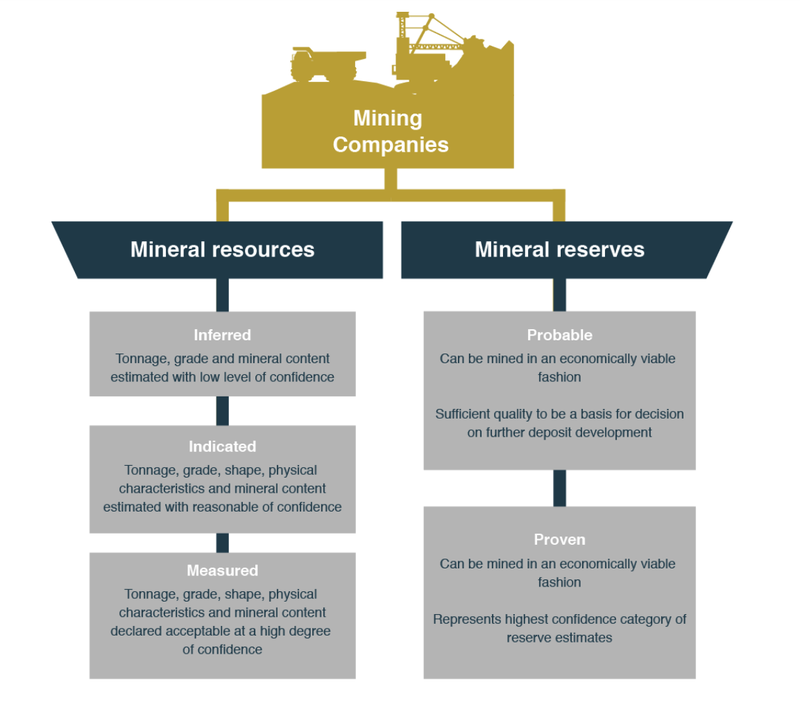
Finding a deposit is only the first step. Defining exactly how big the deposit is and the probability that it can be extracted is also very important.
Feasibility Studies: Work out whether it is worth investing money to extract the deposit from the ground.
Once the company has established the size and quality of the deposit, they need to figure out whether it is worth investing the massive amounts of cash it will take to build the infrastructure required to extract and ship the stuff.
Building a mine or processing plant is not cheap. The company needs to be 100% certain that investing all that money is going to get them (and YOU, the shareholder) a return on investment.
This is where feasibility studies comes in.
A feasibility study is an evaluation of a proposed project to determine whether the discovered and defined deposit can be extracted economically (and profitably)
There are four types of feasibility studies:
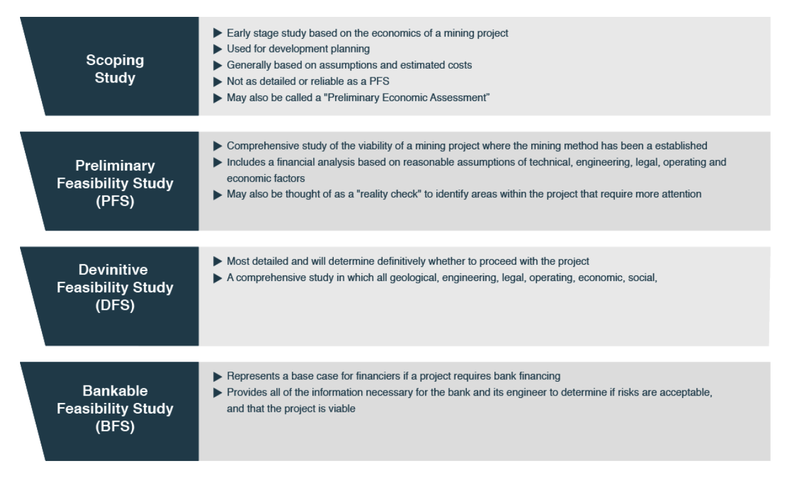
Development: Design and construct all the stuff required to extract the deposit and ship it to market for sale.
Let’s assume all of the feasibility studies justify the construction of the required infrastructure to extract the deposit and confirm that it will be profitable to do so.
This is good news for the company because it means they are one step closer to actually making some money.
To start making money, access to the deposit is required. In mining this will be achieved by open cut or underground mining methods.
Construction requires a great deal of capital investment, so the sooner production starts, the sooner the company will finally start earning money after having spent millions of dollars over years of exploration, planning and feasibility studies.
This development phase is where many share prices lag as there is less ‘excitement’ being generated by news flow.
The objective for a company is to complete development and construction on schedule and within budget. Delays and cost overruns will often cause negative sentiment and reduction in the share price of a developing company.
Production: Start extracting and shipping (making money)
Once construction has been completed and everything has been tested to verify it functions according to its design specifications, improvements in the share price should occur as value of the company becomes fully realised.
Teething problems can be quite common during the testing stages. Those shareholders who have unrealistic expectations of a seamless transition, from development to production, may panic and sell out of their position when problems arise during this stage.
Production is what every exploration company sets out to achieve, and essentially it means they are pulling stuff out of the ground and selling it. Investors at this stage should be very closely watching production rates (how much is being produced, and how fast, for how much profit).
In a producing company’s quarterly report, you will find details on the company’s production for that quarter.
We use a gold producing company as an example here, but a similar process follows for iron ore, base metals and oil & gas companies.
Permitting
The entire life cycle of a company is laden with permits. Explorers must get permits to explore a piece of land, permits to extract resources from the land, and permits to construct a production facility.
When applying for a permit, the mining company will present to the required agencies a comprehensive document that outlines the proposed impacts, and how these impacts can be mitigated. Delays to permitting or at worst case, rejection, can have a significant effect on the share price of a resource company.
The Environmental Impact Study
An Environmental Impact Study (EIS) must be completed before a company can receive approval to build a production facility. The EIS addresses the possible environmental, economic and social impacts, both positive and negative, that would result from extracting the discovered resource.
In the EIS, all potential impacts are addressed including but not limited to: impacts on wildlife, aquatic and terrestrial habitats, socio-economics (disruptions to local communities including first nations land), noise and air and water pollution
The EIS has to show that the benefits of building the production facility outweigh all the possible negatives. Otherwise, the government is unlikely to grant permission for construction. The EIS is disclosed to agencies involved in making decisions on the project. Whether or not a company is granted a permit on a project is dependent on the information contained in the EIS. If all or parts of the EIS are rejected, the proposer is usually given a chance to make adjustments and reapply.
Typical Risks
Mining and Oil & Gas projects have many different risks and an investor in junior resource stocks must be aware of these risks involved prior to an investment.
Typical risks include:
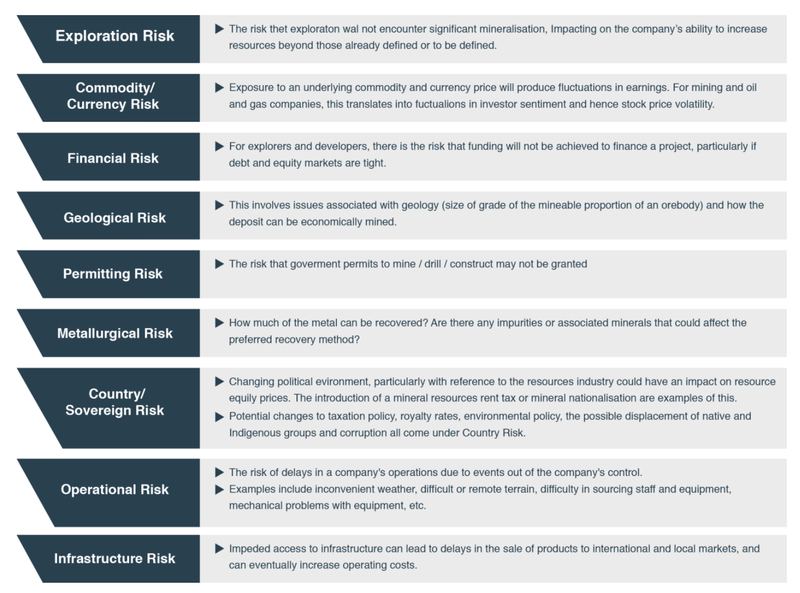
Typical share price performance throughout the resource company lifecycle:
So we now have a better understanding of a resource company’s lifecycle, but the question for investors like us is always - What does this mean for the share price?
The share price typically has three phases to it:
- Exploration I: Which correlates with the exploration and definition phases of the company lifecycle.
- Exploration II: Which correlates with the feasibility studies phases of the company lifecycle.
- Producers: Which begins when a resource company commences construction and eventually starts producing its commodity.
The below image shows how the share price chart of a typical resource company would look:
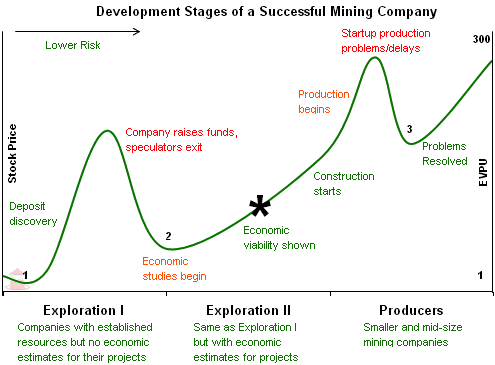
General Information Only
S3 Consortium Pty Ltd (S3, ‘we’, ‘us’, ‘our’) (CAR No. 433913) is a corporate authorised representative of LeMessurier Securities Pty Ltd (AFSL No. 296877). The information contained in this article is general information and is for informational purposes only. Any advice is general advice only. Any advice contained in this article does not constitute personal advice and S3 has not taken into consideration your personal objectives, financial situation or needs. Please seek your own independent professional advice before making any financial investment decision. Those persons acting upon information contained in this article do so entirely at their own risk.
Conflicts of Interest Notice
S3 and its associated entities may hold investments in companies featured in its articles, including through being paid in the securities of the companies we provide commentary on. We disclose the securities held in relation to a particular company that we provide commentary on. Refer to our Disclosure Policy for information on our self-imposed trading blackouts, hold conditions and de-risking (sell conditions) which seek to mitigate against any potential conflicts of interest.
Publication Notice and Disclaimer
The information contained in this article is current as at the publication date. At the time of publishing, the information contained in this article is based on sources which are available in the public domain that we consider to be reliable, and our own analysis of those sources. The views of the author may not reflect the views of the AFSL holder. Any decision by you to purchase securities in the companies featured in this article should be done so after you have sought your own independent professional advice regarding this information and made your own inquiries as to the validity of any information in this article.
Any forward-looking statements contained in this article are not guarantees or predictions of future performance, and involve known and unknown risks, uncertainties and other factors, many of which are beyond our control, and which may cause actual results or performance of companies featured to differ materially from those expressed in the statements contained in this article. S3 cannot and does not give any assurance that the results or performance expressed or implied by any forward-looking statements contained in this article will actually occur and readers are cautioned not to put undue reliance on forward-looking statements.
This article may include references to our past investing performance. Past performance is not a reliable indicator of our future investing performance.



